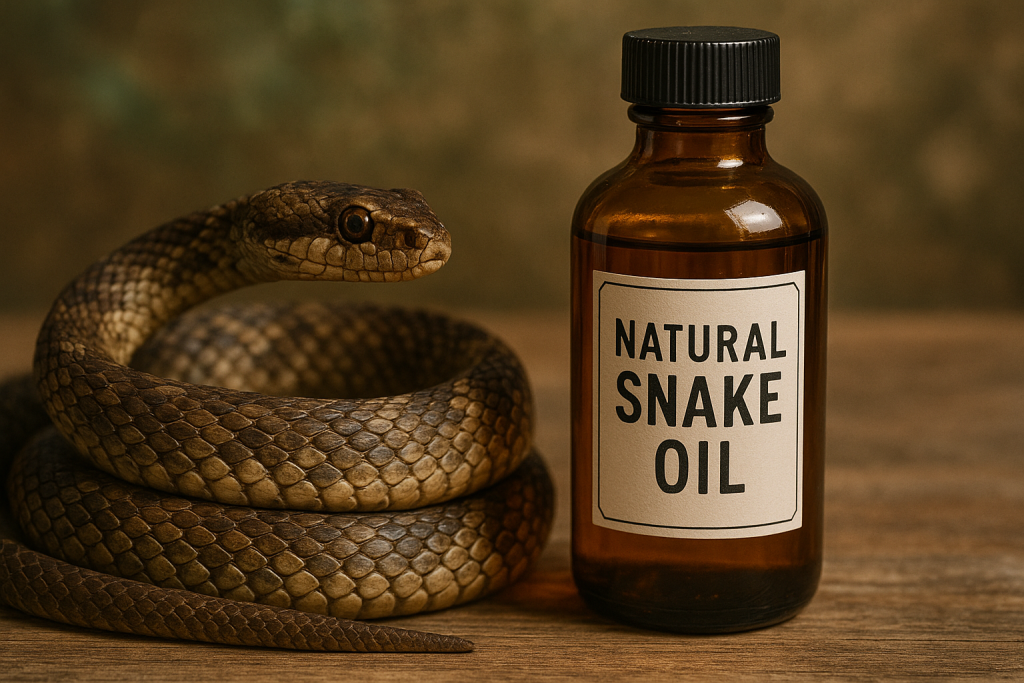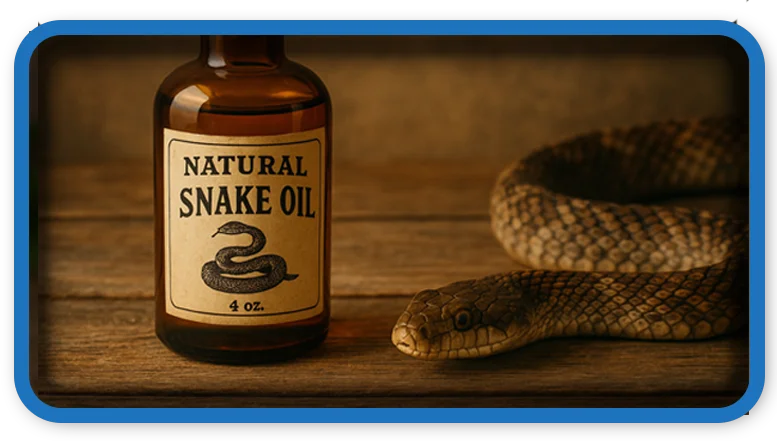⏲️ Estimated reading time: 5 min
Discover the truth behind 100% natural snake oil: is it a time-tested remedy or just a slick marketing trick? We explore its origins, ingredients, uses, and scientific evidence in this in-depth look at this controversial product.
What Is 100% Natural Snake Oil?
“Snake oil” often conjures images of traveling salesmen in the Wild West, selling miracle cures from horse-drawn wagons. But did you know that real snake oil especially the kind labeled “100% natural” has a long and complex history? Originally derived from Chinese water snakes, snake oil was once genuinely used for joint pain and inflammation.
Today, the term can refer to a variety of natural oils claiming medicinal or therapeutic effects. Modern “100% natural snake oil” typically includes snake-derived fat or essential oils infused with botanical extracts. But does it live up to its name, or is it just clever branding?

Origins of Snake Oil
The concept of using snake oil as a healing balm dates back centuries, particularly in Chinese medicine. Chinese water snake oil was rich in omega-3 fatty acids, specifically eicosapentaenoic acid (EPA), which has anti-inflammatory properties. Chinese railroad workers introduced snake oil to the U.S. in the 1800s, using it to soothe muscles after long hours of labor.
However, when American entrepreneurs tried to replicate the formula, they often used rattlesnakes or synthetic mixtures, which lacked the original’s efficacy. This led to the term “snake oil salesman” becoming synonymous with fraud.
Ingredients in Modern Natural Snake Oil
Modern formulations that are labeled “100% natural snake oil” vary greatly but may include:
- Real snake fat extract: Usually from non-venomous snakes like pythons or sea snakes.
- Carrier oils: Such as olive oil, jojoba oil, or coconut oil.
- Essential oils: Including eucalyptus, tea tree, or lavender for added therapeutic benefits.
- Herbal infusions: Like turmeric, arnica, or ginger for anti-inflammatory properties.
Some versions avoid using actual snake fat and instead mimic the original concept using plant-based alternatives, while still being marketed under the “snake oil” brand for its mystique and traditional association.
Snake oil: why is it so successful?
Claimed Benefits, proponents of 100% natural snake oil claim it can:
- Relieve joint and muscle pain
- Reduce inflammation
- Improve skin conditions like eczema or psoriasis
- Enhance hair growth and reduce dandruff
- Act as an anti-aging serum
These claims often stem from the oil’s omega-3 content and the addition of herbs and essential oils known for their healing properties. However, the scientific backing varies depending on the formulation and actual ingredients used.
What Science Says
While omega-3 fatty acids are proven to reduce inflammation, studies on modern snake oil products are limited. The original Chinese snake oil had real therapeutic potential, but many modern products lack the same composition or concentration of active ingredients.
In one case, an analysis of a commercially sold snake oil product in the U.S. found no detectable omega-3s at all. That doesn’t mean all snake oil is bogus some high-quality, properly sourced oils may offer real benefits. The key is knowing what you’re getting.
How to Use Natural Snake Oil Safely
If you’re curious about trying 100% natural snake oil, here are some tips:
- Read the label: Ensure it lists actual ingredients, preferably with botanical names and concentration levels.
- Patch test: Before using it on large areas of skin or scalp, do a small patch test to check for allergic reactions.
- Consult a professional: If you have chronic health conditions or are on medication, check with a doctor or dermatologist.
- Topical use only: Never ingest snake oil unless it is explicitly formulated and certified for internal use.
- Avoid vague brands: Products without a clear origin or certification are more likely to be ineffective or even harmful.
Ethical and Sustainability Concerns
Some consumers may wonder whether using snake oil is ethical. The harvesting of snake fat can raise animal welfare and conservation concerns. Fortunately, many “100% natural” products today use lab-created analogs or sustainable farming methods that don’t harm endangered species.
If you’re concerned about animal rights, you can also look for vegan alternatives that simulate the properties of snake oil using plant-based omega oils and natural extracts.
Consumer Caution: Not All Snake Oils Are Created Equal
The modern wellness market is flooded with products that use traditional names to capitalize on consumer curiosity. Just because a product is labeled “100% natural” doesn’t mean it’s effective or safe. Some may be diluted, falsely marketed, or contain undisclosed chemicals.
Always verify certifications (such as USDA Organic or third-party lab tests), look for reputable reviews, and avoid products with overly grandiose promises.
The Final Verdict
100% natural snake oil exists in a gray area between tradition, alternative wellness, and modern skepticism. While it may offer real benefits when properly formulated and ethically sourced, the lack of regulation and standardization means consumers must do their homework.
Whether you view it as a miracle balm or a modern myth, one thing is clear: education and transparency are key when exploring any natural remedy.
📩 Do you have questions or suggestions? Leave a comment or contact us!
🏷️ Tags: snake oil, natural remedies, wellness, alternative medicine, joint pain relief, skincare, herbal oil, anti-inflammatory, omega-3, traditional medicine
Only logged-in users can submit reports.
Discover more from HelpZone
Subscribe to get the latest posts sent to your email.

